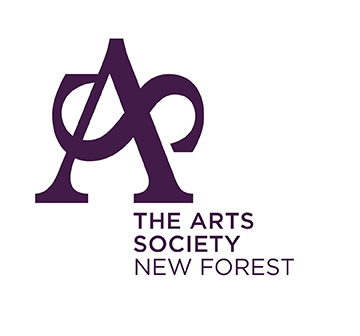TASNF SID– February 26th 2024
E.H.Shepard – James Campbell (married to Shepard’s great granddaughter)
The three lectures :
1. World War One
2. Shepard and A.A. Milne collaboration
3. Royalty (he lived through the reigns of 6 monarchs).
Ernest Howard Shepard was born in 1879 and died in 1976. His mother died when he was 10 years old and his father died when he was 25. He had a brother Cyril, a Lloyd’s underwriter, who was killed in the Somme and a sister, Ethel, who became a missionary. He met Florence Chaplin, while studying at the Royal Academy Schools. She was the grandchild of Punch founder, Ebenezer Landells. They married and had two children. He was heartbroken when she died in 1927. In 1943, Shepard married again to Norah Carroll, a nurse.
1. World War One
In 1914 Shepard was married with two young children, living near Guilford. He was a professional Illustrator for journals such as Punch and the Illustrated London News and providing dust jackets for books. He attempted to enlist at the start of the war but was initially turned down. He tried to provide a lighter note in his cartoons during the early days of war, which ‘ was meant to be over by Christmas.’
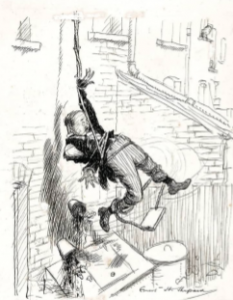
In 1915, he enlisted as an officer. He joined the Royal Artillery, allocated the 105 Siege Battery (. gun on wheels) He was sent to France in January 1916, they discovered that their guns had not arrived. The French loaned them some until theirs turned up. carried a notebook and made many sketches, some archived in the Imperial War Museum. He did sketches of the Battery, their accommodation, and produced landscapes in watercolour; at first sight idyllic until you clocked the shells exploding overhead. He continued to send back cartoons for publication, which depicted the cold desolation.
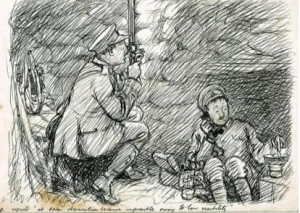
He was present at the Battle of the Somme. His older brother Cyril was killed nearby but he was unaware for several days.
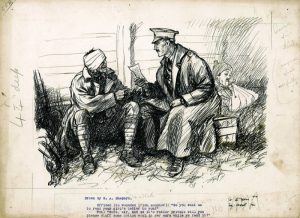
His drawing ability was spotted and he was invited to join the Intelligence Corps. He participated in the 3rd battle of Ypres, Passchendaele. Leave was cancelled and the field battery was sent to Northern Italy. There were no maps available so he had to resort to an automobile tourist map of 1912.
He portrayed the Refugees fleeing from the Italian front, the British soldiers marching in the opposite direction.
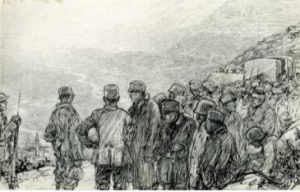
He ran out of drawing materials and was amazed to receive his order from Gamages, four days later. He struck up an acquaintance when he gave a lift to a wounded American, it was Ernest Hemingway. He was promoted from 2nd Lieutenant to Acting Major by the end of the war. At war end, he was required to stay on in Italy to help with the wind down.
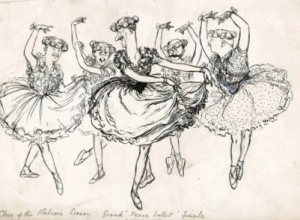
The family said he never spoke about his war experiences. He won a Military Cross.
2. The Art of Winnie the Pooh
AA Milne was a celebrated playwright. One wet holiday in Wales, he retreated to the summer house and produced some children’s poems, which he worked up into a book and persuaded by his wife, showed them to his publisher.
EH Shepard was not the first person to decorate AA Milne’s poems. Both men worked for Punch and AA Milnes publisher, EB Lucas recommended EH Shepard. At that time, it was the publisher who organised the illustrations, not the author. Alan was not a fan of Shepards past work but was pleased with the drawings Shepard made for him.
Winnie the Pooh was based on a combination of Christopher Robin’s teddy bear and Graham Shepard’s (his son) one called Growler. He also provided a Christopher robins mother had wanted a daughter and tended to dress him as a girl).
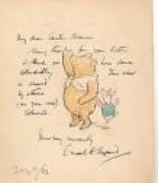
The poems, ‘When we were very Young’ were published in 1924 and were an instant hit, both in England and America. ‘Everyone realised the key success was due to the resonance between the text and the illustrations.’ The bear was a great success and Alan was commissioned to write a book ‘Winnie the Pooh’. Alan insisted Shepard did the illustrations. There was a glitch, Shepard was paid £50.00 but Alan had received a lot more. This time, Shepard was given a share and each week, Shepard, Alan, and EB Lucas would meet in London; a collaboration not seen before. Shepard would draw on flimsy paper, considerations had to be made for which side the page was on, to ensure the reader’s eye was drawn in. Christopher Robin’s toys were the same size but, over time, their size would vary. In the early versions Eeyore was smaller and Tigger’s eyes weren’t right. The drawings were all in black and white, colour was only introduced after WW2.
In 1930 the licensing rights for America and Canada were bought by Stephen Slesinger. He died in 1953 and Dorothy licensed the rights to Disney in 1961.
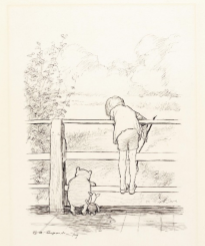
The book was also a great success. Alan planned to write his next book, ‘Now we are 6’. Alan’s wife , Dorothy, did not consider Shepard as a social equal and was distant on his visits to Ashdown Forest. Should Pooh wear clothes in the snow? He did not, in the Disney cartoons, he wears a red T shirt.
Two weeks before the book was published Shepard’s wife died, during minor surgery. He was devastated and those first few weeks were the only time he stopped drawing. Alan decided to bring forward his work on ‘House at Pooh Corner’ to help Shepard come to terms with his loss. Alan introduced Roo and Tigger. Tigger was always drawn higher than the other animals to portray his ‘bounce’. This was to be the last book in the series.
Christopher Robin had a difficult relationship with his parents, ably illustrated in the film, ‘ Goodbye, Christopher Robin’.
AA Milne wrote no more books, he returned to playwriting and died in 1956, his widow, donated his originals to the V&A without consulting Shepard; there has only been one exhibition since, in 1917.
Shepard continued to draw Winnie the Pooh et al for multiple editions (different page sizes), foreign languages and answering letters with drawings. He illustrated ‘Wind in the Willows’.
He was dismissed from Punch by Malcolm Muggeridge in 1957. Coloured editions of Pooh emerged in the 1960’s. His first published drawing was when he was eight years old and his last was when he was ninety-five.
3. How He Drew The Royal Family
Shepard’s drawings of the royal family were unusual for the time because he portrayed them in a contemporary, relaxed, and informal way. James Campbell acknowledged that portraiture was not his strong point.
Historic drawings:
He did sketches of Queen Victoria being given the news that she was now Queen. She had walked down the staircase unaided for the first time.
Another was of Queen Victoria proposing to Prince Albert at Buckingham Place (both aged 21).
One of her ‘not being amused’, Prince Albert walking out on her, after a row. One of Prince albert shaving and her listening. Queen Victoria did not like Gladstone and made him stand during his audiences with her. However, she let his widow sit while she conveyed her condolences.
He did sketches of her with John Brown and of her Golden Jubilee.
He produced a sketch of the marriage of King George V and Mary, he had seen the Bayeux tapestry the year before and imitated it for the marriage procession.
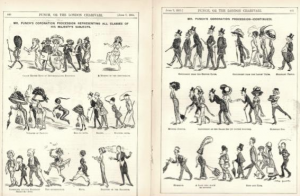
Another sketch was of Kaiser Wilhelm, who had a withered arm. The Kaiser blamed the midwife sent by Queen Victoria for this disability.
Punch magazine was keen on portraying Royal Anniversaries, produced a series on Kings and Queens of London, another on British Royalty. His was of King George III.
Shepard produced a sketch for the Silver Jubilee of George V, of the death of George V.
Shepard had met Edward VIII, before he became king, on the Western Front. He opened the front door of their billet, with an apron on, in the middle of cooking lunch. The future king was invited in for a drink.
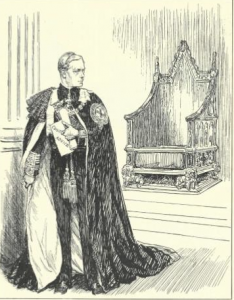
Shepard drew a cartoon George VII coronation with a backdrop of Windsor Castle, and another of Mr. Punch’s dog with the Princesses Elizabeth and Margaret Rose. He drew a cartoon of the Royal Visit to America, in 1939, of George VI shaking hands with George Washington (Uncle Sam). He was chief cartoonist for Punch at this time.
When Princess Elizabeth was married, he did a drawing of her coach being pulled by a sample of people including Shakespeare.
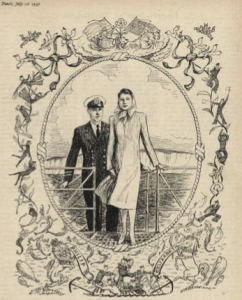
True to form, when he did a picture of King George VI and Queen Elizabeth for their silver wedding, he changed the King’s dress to a more informal lounge suit.
His drawing of the King lying in state was a poignant one, the king’s death was a shock to the nation.
The late Queen presented Shepard with an OBE.
(If you are interested, you can find many of the above Punch cartoons mentioned online, but I was unable to reproduce them).
